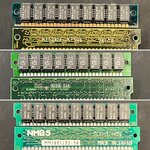RolandJuno
Active member
Hey all! A little over a month ago, I embarked on a project to build a new Lisa! For years, I've had a Lisa CPU card given to me by a friend (no idea of its status). Now with the availability of new reproduction motherboard and I/O cards, I've build up the missing cards (and sourced a new bare SunRem 2MB RAM card). I sourced all the parts and assembled it. (DosFox was already successful and has a working Lisa 2/5 from scratch.)
Much to my surprise, it eventually booted and gave an error during the startup test phase (along with two beeps, lo/hi). Error 45 is a "bus error" but I'm not certain how to begin to troubleshoot it. The error happens shortly after it begins the memory test so I'm assuming it's a RAM problem? [Link to video of startup]

Anyone have ideas of how to proceed?
BTW, I'm using W27C512 in place of the 6309 for both the video and floppy PROMs (which seem to be working, given the picture I'm getting). I'm also using the COP421 EMU board.
BTW, you can see my progress on this Mastodon thread:
https://mastodon.social/@paulrickards/110895001422227651
Much to my surprise, it eventually booted and gave an error during the startup test phase (along with two beeps, lo/hi). Error 45 is a "bus error" but I'm not certain how to begin to troubleshoot it. The error happens shortly after it begins the memory test so I'm assuming it's a RAM problem? [Link to video of startup]

Anyone have ideas of how to proceed?
BTW, I'm using W27C512 in place of the 6309 for both the video and floppy PROMs (which seem to be working, given the picture I'm getting). I'm also using the COP421 EMU board.
BTW, you can see my progress on this Mastodon thread:
https://mastodon.social/@paulrickards/110895001422227651


